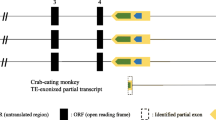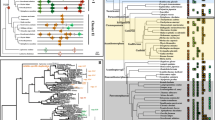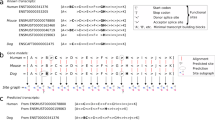Abstract
Human GARS-AIRS-GART encodes a fused tri-functional enzyme protein involved in de novo purine biosynthesis, aberrant function being implicated in Down syndrome and Leukemia. We performed phylogenetic analysis to discern evolutionary relationships and in silico characterization to identify elements potentially important for gene regulation. We report that murine, bovine and chimpanzee sequences are the nearest neighbors of human GARS-AIRS-GART and that endo-duplication of the AIRS protein is restricted to insect orthologs. Convergent evolution of mono-functional bacterial orthologs to bi-functional, partly fused, yeast orthologs is observed from the rooted-NJ tree topology that bears bootstrap values exceeding 9000 in majority of the nodes. Sequence alignments reveal that introns 11–15 of human GARS-AIRS-GART are conserved among vertebrates. An inverse correlation is observed between intron size and intron density without bias for intron position. The generation time of organisms is independent of intron density. Human, bovine and murine sequences possess similar GC content with CpG islands in promoter regions. The long isoforms of cow and chicken transcripts and short isoforms of human, bovine and murine mRNA form energetically stable stem-like structures in the 3′-UTR and may regulate translational stability of GARS-AIRS-GART transcripts. Glycine-rich loops important for enzyme structure and ATP-, folate-binding residues are partially conserved.





Similar content being viewed by others
References
Patterson, D., Graw, S., & Jones, C. (1981). Demonstration by somatic cell genetics, of coordinate regulation of genes for two enzymes of purine synthesis assigned to human chromosome 21. Proceedings of the National Academy of Sciences of the United States of America, 78, 405–409. doi:10.1073/pnas.78.1.405.
Hard, R. G., Benkovic, S. J., Van Keuren, M. L., Graw, S. L., Drabkin, H. A., & Patterson, D. (1986). Assignment of a third purine biosynthetic gene (glycinamide ribonucleotide transformylase) to human chromosome 21. American Journal of Human Genetics, 39, 179–185.
Hattori, M., Fujiyama, A., Taylor, T. D., Watanabe, H., Yada, T., Park, H. S., et al. (2000). The DNA sequence of human chromosome 21. Nature, 405, 311–319. doi:10.1038/35012518.
Kappock, T. J., Ealick, S. E., & Stubbe, J. A. (2000). Modular evolution of the purine biosynthetic pathway. Current Opinion in Chemical Biology, 4, 567–572. doi:10.1016/S1367-5931(00)00133-2.
Epstein, C. J. (2001). Down syndrome (Trisomy21). In C. R. Scriver, A. L. Beaudet, D. Valle, W. S. Sly, B. Childs, K. W. Kinzler, B. Vogelstein (Eds.), Metabolic and molecular bases of inherited diseases (Vol. 1, pp. 1223–1256). New York: McGraw Hill Medical Publishing Division.
Zaza, G., yang, W., Kager, L., Cheok, M., Downing, J., Pui, C.-H., et al. (2004). Acute lymphoblastic leukemia with TEL-AML1 fusion has lower expression of genes involved in purine metabolism and lower de novo purine synthesis. Blood, 104, 1435–1441. doi:10.1182/blood-2003-12-4306.
Smith, J. M., Daum, H. A., & II, I. (1986). Nucleotide sequence of the purM gene encoding 5′-Phosphoribosyl-5-aminoimidazole synthetase of Escherichia coli K12. The Journal of Biological Chemistry, 261, 10632–10636.
Smith, J. M., Daum, H. A., & II, I. (1987). Identification and nucleotide sequence of a gene encoding 5′-phosphoribosylglycinamide transformylase in Escherichia coli K12. The Journal of Biological Chemistry, 262, 10565–10569.
Aiba, A., & Mizobuchi, K. (1989). Nucleotide sequence analysis of genes purH and purD involved in the de novo purine nucleotide biosynthesis of Escherichia coli. The Journal of Biological Chemistry, 264, 21239–21246.
Schild, D., Brake, A. J., Kiefer, M. C., Young, D., & Barr, J. (1990). Cloning of three human multifunctional de novo purine biosynthetic genes by functional complementation of yeast mutations. Proceedings of the National Academy of Sciences of the United States of America, 87, 2916–2920. doi:10.1073/pnas.87.8.2916.
Henikoff, S., Keene, M. A., Sloan, J. S., Bleskan, J., Hards, R., & Patterson, D. (1986). Multiple purine pathway enzyme activities are encoded at a single genetic locus in Drosophila. Proceedings of the National Academy of Sciences of the United States of America, 83, 720–724. doi:10.1073/pnas.83.3.720.
Aimi, J., Qiu, H., Williams, J., Zalkin, H., & Dixon, J. E. (1990). De novo purine nucleotide biosynthesis: Cloning of human and avian cDNAs encoding the trifunctional glycinamide ribonucleotide synthetase-aminoimidazole ribonucleotide synthetase-glycinamide ribonucloetide transformylase by functional complementation in E. coli. Nucleic Acids Research, 18, 6665–6672. doi:10.1093/nar/18.22.6665.
Kan, J. L. C., & Moran, R. G. (1995). Analysis of a mouse gene encoding three steps of purine synthesis reveals use of an intronic polyadenylation signal without alternative exon usage. The Journal of Biological Chemistry, 270, 1823–1832. doi:10.1074/jbc.270.4.1823.
Wohlke, A., Drogemuller, C., Kuiper, H., Leeb, T., & Distl, O. (2005). Molecular characterization and chromosomal assignment of the bovine glycinamide ribonucleotide formyltransferase (GART) gene on cattle chromosome 1q12.1–1q12.2. Gene, 348, 73–81. doi:10.1016/j.gene.2004.12.038.
Zhang, Y., Desharnais, J., Greasley, S. E., Beardsley, G. P., Boger, D. L., & Wilson, I. A. (2002). Crystal structure of human GARTfase at low and high pH and with substrate β-GAR. Biochemistry, 41, 14206–14215. doi:10.1021/bi020522m.
Dahms, T. E. S., Sainz, G., Giroux, E. L., Caperelli, C. A., & Smith, J. L. (2005). The apo and ternary complex structures of a chemotherapeutic target: Human glycinamide ribonucleotide transformylase. Biochemistry, 44, 9841–9850. doi:10.1021/bi050307g.
Wang, W., Kappock, T. J., Stubbe, J. A., & Ealick, S. E. (1998). X-ray crystal structure of the glycinamide ribonucleotide synthetase from Escherichia coli. Biochemistry, 37, 15647–15662. doi:10.1021/bi981405n.
Li, C., Kappock, T. J., Stubbe, J. A., Weaver, T. M., & Ealick, S. E. (1999). X-ray crystal structure of aminoimidazole ribonucleotide synthetase (PurM), from the Escherichia coli purine biosynthetic pathway at 2.5 Ǻ resolution. Structure (London, England), 7, 1155–1166. doi:10.1016/S0969-2126(99)80182-8.
Bronder, J. L., & Moran, R. G. (2003). A defect in the p53 response pathway induced by de novo purine synthesis inhibition. The Journal of Biological Chemistry, 278, 48861–48871. doi:10.1074/jbc.M304844200.
Brodsky, G., Barnes, T., Bleskan, J., Becker, L., Cox, M., & Patterson, D. (1997). The human GARS-AIRS-GART gene encodes two proteins which are differentially expressed during human brain development and temporally over-expressed in cerebellum of individuals with Down syndrome. Human Molecular Genetics, 6, 2043–2050. doi:10.1093/hmg/6.12.2043.
Thompson, J. D., Gibson, T. J., Plewniak, F., Jeanmougin, F., & Higgins, D. G. (1997). The CLUSTAL-X windows interface: Flexible strategies for multiple sequence alignment aided by quality analysis tools. Nucleic Acids Research, 25, 4876–4882. doi:10.1093/nar/25.24.4876.
Hall, B. G. (2004) Comparison of the accuracies of several phylogenetic methods using protein and DNA sequences. Molecular Biology and Evolution, 22, 792–802 [Hall, B. G., Tune-Clustal-X v 1.01 (Macintosh) distributed by the author, Bellingham, WA].
Valdar, W. S. J. (2002). Scoring residue conservation. Proteins: Structure, Function and Genetics, 48, 227–241. doi:10.1002/prot.10146.
Felsenstein, J. (1989). PHYLIP––phylogeny inference package (Version 3.2). Cladistics, 5, 164–166.
Felsenstein, J. (2005). PHYLIP (Phylogeny Inference Package) version 3.6. Department of Genome Sciences, University of Washington, Seattle, http://www.evolution.genetics.washington.edu/phylip.html [Distributed by the author].
Sultan, S., Manecksha, R., O’ Sullivan, J., Hynes, N., Quill, D., & Courtney, D. (2004). Survival of ruptured abdominal aortic aneurysms in the west of Ireland: Do prognostic indicators of outcome exist? Vascular and Endovascular Surgery, 38, 43–49. doi:10.1177/153857440403800105.
Scherf, M., Klingenhoff, A., & Werner, T. (2000). Highly specific localization of promoter regions in large genomic sequences by PromoterInspector: A novel context analysis approach. Journal of Molecular Biology, 297, 599–606. doi:10.1006/jmbi.2000.3589.
Bajic, V. B., & Seah, S. H. (2003). Dragon gene start finder: An advanced system for finding approximate locations of the start of gene transcriptional units. Genome Research, 13, 1923–1929.
Rice, P., Longden, I., & Bleasby, A. (2000). EMBOSS: The European molecular biology open software suite. Trends in Genetics, 16, 276–277. doi:10.1016/S0168-9525(00)02024-2.
Brodsky, L. I., Ivanov, V. V., Kalaydzidis, Y. L., Leontovich, A. M., Nikolaev, V. K., Feranchuk, S. I., et al. (1995). GeneBee-NET: Internet-based server for analyzing biopolymers structure. Biochemistry, 60, 923–928.
Thompson, J. D., Higgins, D. G., & Gibson, T. J. (1994). ClustalW: Improving the sensitivity of progressive multiple sequence alignment through sequence weighting, position specific gap penalties and weight matrix choice. Nucleic Acids Research, 22, 4673–4680. doi:10.1093/nar/22.22.4673.
Zuker, M. (2003). Mfold web server for nucleic acid folding and hybridization prediction. Nucleic Acids Research, 31, 3406–3415. doi:10.1093/nar/gkg595.
Henikoff, S., Sloan, J. S., & Kelly, J. D. (1983). A Drosophila metabolic gene transcript is alternatively processed. Cell, 34, 405–414. doi:10.1016/0092-8674(83)90374-4.
Clark, D. V., & Henikoff, S. (1992). Unusual organizational features of the Drosophila GART locus are not observed within Diptera. Journal of Molecular Evolution, 35, 51–59. doi:10.1007/BF00160260.
Henikoff, S., & Eghtedarzadeh, M. K. (1987). Conserved arrangements of nested genes at the Drosophila GART locus. Genetics, 117, 711–725.
Jeffares, D. C., Mourier, T., & Penny, D. (2006). The biology of intron gain and loss. Trends in Genetics, 22, 16–22. doi:10.1016/j.tig.2005.10.006.
Banerjee, D., & Nandagopal, K. (2007). Potential interaction between the GARS-AIRS-GART gene and CP2/LBP-1c/LSF transcription factor in Down syndrome-related Alzheimer Disease. Cellular and Molecular Neurobiology, 27, 1117–1126. doi:10.1007/s10571-007-9217-2.
Alexiou, M., & Leese, H. J. (1992). Purine utilization, de novo synthesis and degradation in mouse pre-implantation embryo. Development, 114, 185–192.
Malmanche, N., & Clark, D. V. (2004). Drosophila melanogaster Prat, a purine de novo synthesis gene, has a pleiotropic maternal effect phenotype. Genetics, 168, 2011–2023. doi:10.1534/genetics.104.033134.
Kan, J. L. C., & Moran, R. G. (1997). Intronic polyadenylation in the human glycinamide ribonucleotide formyltransferase gene. Nucleic Acids Research, 25, 3118–3123. doi:10.1093/nar/25.15.3118.
Vinogradov, A. E. (2005). Dualism of gene GC content and CpG pattern in regard to expression in the human genome: Magnitude versus breadth. Trends in Genetics, 21, 639–643. doi:10.1016/j.tig.2005.09.002.
Suzuki, M. M., Kerr, A. R. W., De Sousa, D., & Bird, A. (2007). CpG methylation is targeted to transcription units in invertebrate genome. Genome Research, 17, 625–631. doi:10.1101/gr.6163007.
Lyko, F., Ramsahoye, B. H., Kashevsky, H., Tudor, M., Mastrangelo, M.-A., Orr-Weaver, T. L., et al. (1999). Mammalian (cytosine-5) methyl-transferase cause genomic DNA methylation and lethality in Drosophila. Nature Genetics, 23, 363–366. doi:10.1038/15551.
Roder, K., Hung, M.-S., Lee, T.-L., Lin, T.-Y., Xiao, H., Isobe, K.-I., et al. (2000). Transcriptional repression by Drosophila methyl-CpG-binding proteins. Molecular and Cellular Biology, 20, 7401–7409. doi:10.1128/MCB.20.19.7401-7409.2000.
Knox, A. J., Graham, C., Bleskan, J., Brodsky, G., & Patterson, D. (2008). Mutations in the Chinese hamster ovary cell GART gene of de novo purine biosynthesis. Gene, 429, 23–30.
Acknowledgements
Disha Banerjee is the recipient of a Junior Research Fellowship from CSIR grant 27(0131)/04/EMR-II awarded to Krishnadas Nandagopal. The authors thank Mr. Subhrangshu Guhathakurta (Manovikas Kendra Rehabilitation & Research Institute for the Handicapped, Kolkata, India) for technical assistance with the preparation of figures and Dr. T. K. Mukhopadhyay (Department of Zoology, Presidency College, Kolkata, India) for critical reading of the manuscript.
Author information
Authors and Affiliations
Corresponding author
Electronic Supplementary Material
Below is the link to the electronic supplementary material.
Rights and permissions
About this article
Cite this article
Banerjee, D., Nandagopal, K. Phylogenetic Analysis and in Silico Characterization of the GARS-AIRS-GART Gene which Codes for a tri-Functional Enzyme Protein Involved in de novo Purine Biosynthesis. Mol Biotechnol 42, 306–319 (2009). https://doi.org/10.1007/s12033-009-9160-1
Received:
Accepted:
Published:
Issue Date:
DOI: https://doi.org/10.1007/s12033-009-9160-1




